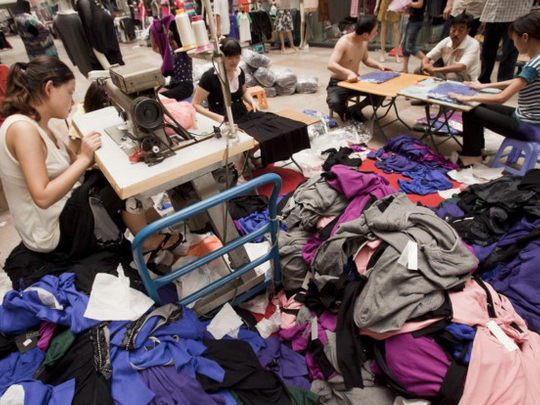
Beijing: Cotton consumption in China, the world’s largest user, may shrink 11 per cent this year as a deteriorating economy hurts demand and causes a buildup in commodities, according to Weiqiao Textile Co.
“The Chinese economy is only at the beginning of a harsh winter,” Zhang Hongxia, chairman of China’s largest cotton-textile maker, said in an interview in Hong Kong on August 20. “China now is facing a situation where everything from coal to steel inventories are piling up.”
Zhang’s outlook runs counter to forecasts from banks such as Goldman Sachs Group Inc that forecast a second-half rebound as the government expands stimulus. China’s economy grew at the slowest pace in three years in the second quarter as Europe’s debt crisis hurt exports and a government drive to cool consumer and property prices damped domestic demand.
“The slowdown in China is due to overall industrial overcapacity accumulated in recent years,” said Lou Zhi, head of the trading department at Hunter Capital Ltd, a Dalian-based commodity hedge fund. “Overseas demand is unlikely to revive soon as the European debt crisis looks set to drag on. Despite a recovery in the US, growth there seems anaemic.”
Cotton usage may drop to 8 million metric tonnes this year, compared with consumption of about 9 million tonnes in 2011, according to Zhang, who had forecast in March that 2012 demand may increase to as much as 9.5 million tons. China accounts for about 40 per cent of global cotton consumption.
Benchmark index
Cotton traded at 76.57 cents a pound on ICE Futures US at 12.51pm in Shanghai after most-active prices fell 28 per cent over the past year. Weiqiao shares, trading at HK$2.78, have lost 33 per cent in the past 12 months as the benchmark Hang Seng Index gained 2.3 per cent. Commodities as tracked by the Standard & Poor’s GSCI Spot Index rose 4.6 per cent in the past year, and rallied more than 20 per cent from the year’s low on June 21.
China’s export growth collapsed in July and industrial output fell short of projections, according to separate reports this month, after data showed the second-largest economy grew 7.6 per cent between April and June. Premier Wen Jiabao said last week that easing inflation allowed more room to adjust monetary policy. The country has cut interest rates twice since June and the reserve requirement ratio three times since November.
‘In contrast’
“My view might be in contrast to what many economists out there are saying,” said Zhang, daughter of Zhang Shiping, whose family hold 744.94 million shares in Weiqiao, according to data compiled by Bloomberg. There may be a so-called turning point for the economy if the government introduces “very good” policies later this year, she said, without elaborating.
Goldman Sachs economists including Hong Kong-based Cui Li said in an August 2 report on China’s economy that “we expect growth to accelerate in the rest of the year and 2013 as supportive policies are gradually rolled out and implemented.” The bank forecast a full-year expansion of 7.9 per cent for 2012, down from an earlier estimate of 8.1 per cent.
Economic growth may accelerate to 7.9 per cent in the third quarter and 8.3 per cent in the final three months, according to the median forecasts in a Bloomberg survey of 21 economists taken from August 14 to August 21. The country is the world’s largest consumer of base metals and second-largest crude user.
Coal inventories at Qinhuangdao port rose to 9.33 million tonnes on June 17, the highest since 2008, data from the China Coal Transport and Distribution Association showed. Stockpiles were at 6.69 million tonnes as of August 19. While steel-product stockpiles at the nation’s 26 major markets have dropped for five months as the end of July, they’re still 19 per cent higher this year, according to the China Iron & Steel Association.
Tough Environment
Commodity-related companies have flagged their concern. Noble Group Ltd, Asia’s biggest listed commodity supplier, expects a tough environment for the next 12 to 24 months, Chief Executive Officer Yusuf Alireza said wEDNESday. Vale SA, the world’s largest iron-ore producer, said this month that China’s so-called golden years are gone as economic growth slows.
“We are in a worse situation now, compared with 2008- 2009,” said Zhang, referring to the country’s textile industry. “The prospect for an economic recovery looks set to drag on, with too many uncertainties in the short term, and the European debt crisis seems to be endless.”
Weiqiao, which normally consumes about 600,000 tons of cotton a year, used 204,000 tonNEs in the first half as capacity usage was reduced to cope with weaker demand and high inventory, Zhang said. Net income at the Zouping county, Shandong-based company fell about 90 per cent in the first half.
Supply Deficit
Cotton production in China doesn’t meet demand and the government distributes import quotas. Output may be 31 million, 480-pound bales (6.7 million tonNEs) in 2012-2013, compared with demand of 39 million bales, according to the US Department of Agriculture. Imports may decline to 13 million bales in 2012- 2013, from 24.3 million bales previous year, the USDA says.
Through an industry association, the company has urged the government either to release additional import quotas, enabling textile makers to benefit from cheaper shipments, or to sell off state stockpiles at a discount, Zhang said. The government has more than 4 million tonNEs held in reserves, she said.
Global cotton stockpiles will increase 10 per cent to 74.67 million 480-pound bales in the 2012-2013 season, according to a forecast from the USDA. Holdings in China will advance 17 per cent to 34.18 million bales.












